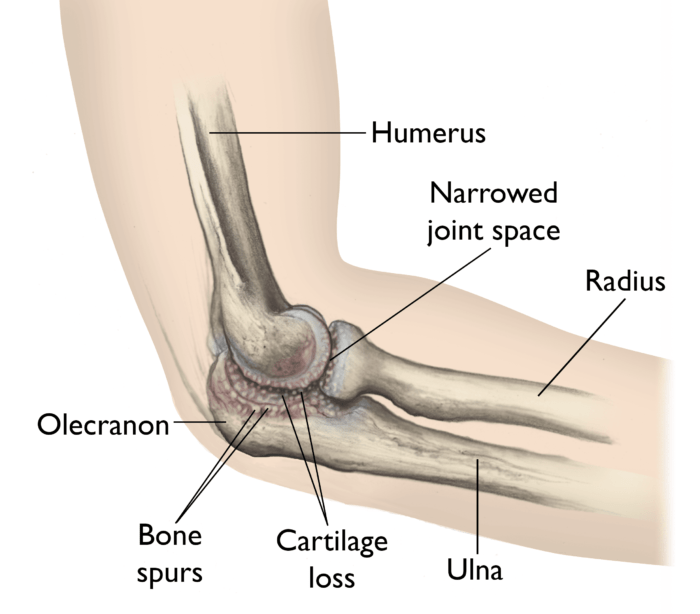Elbow Arthritis
Elbow Arthritis
Osteoarthritis of the elbow occurs when the cartilage surface of the elbow is worn out or damaged. This can happen because of a previous injury such as an elbow dislocation or fracture. Most commonly, however, it is the result of a normal wearing away of the joint cartilage as we age and from years of activity. Osteoarthritis usually affects the weight-bearing joints, such as the hip and knee. The elbow is one of the least affected joints because of its well-matched joint surfaces and strong stabilizing ligaments. As a result, the elbow joint can tolerate large forces across it without becoming unstable.
Anatomy
The elbow is a hinge joint which is made up of three bones:
- The humerus (upper arm bone)
- The ulna (forearm bone on the pinky finger side)
- The radius (forearm bone on the thumb side)

The surfaces of the bones where they meet to form the elbow joint are covered with articular cartilage, a smooth substance that protects the bones and enables them to move easily. A thin, smooth tissue called synovial membrane covers all remaining surfaces inside the elbow joint. In a healthy elbow, this membrane makes a small amount of fluid that lubricates the cartilage and eliminates almost any friction as you bend and rotate your arm.
Muscles, ligaments, and tendons hold the elbow joint together.
Elbow Arthritis

Need help? Contact me
+91- 9958446289 or mvivek@hotmail.com
Symptoms
The most common symptoms of elbow arthritis are:
- Pain
- Loss of range of motion
These symptoms may not occur at the same time. Patients usually report a grating or locking sensation in the elbow.
- The grating is due to loss of the normal smooth joint surface. This is caused by cartilage damage or wear.
- The locking is caused by loose pieces of cartilage or bone that dislodge from the joint and become trapped between the moving joint surfaces, blocking motion.
Joint swelling may also occur, but this does not usually happen at first. Swelling occurs later, as the disease progresses.
In the later stages of osteoarthritis of the elbow, patients may notice numbness in their ring finger and small (pinky) finger. This can be caused by elbow swelling or limited range of motion in the joint. The ulnar nerve (funny bone) is located in a tunnel behind the inner (medial) side of the elbow. Swelling in the elbow joint can put increased pressure on the nerve, causing tingling. If the elbow cannot be moved through its normal range of motion, it may stiffen into a position where it is bent (flexion). This can also cause pressure around the nerve to increase.
